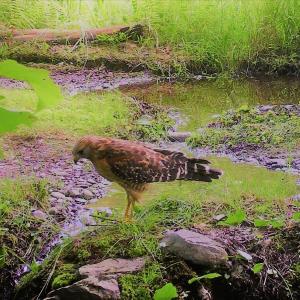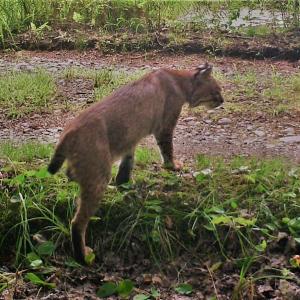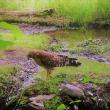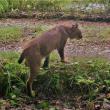Mystery Hawk in Jefferson
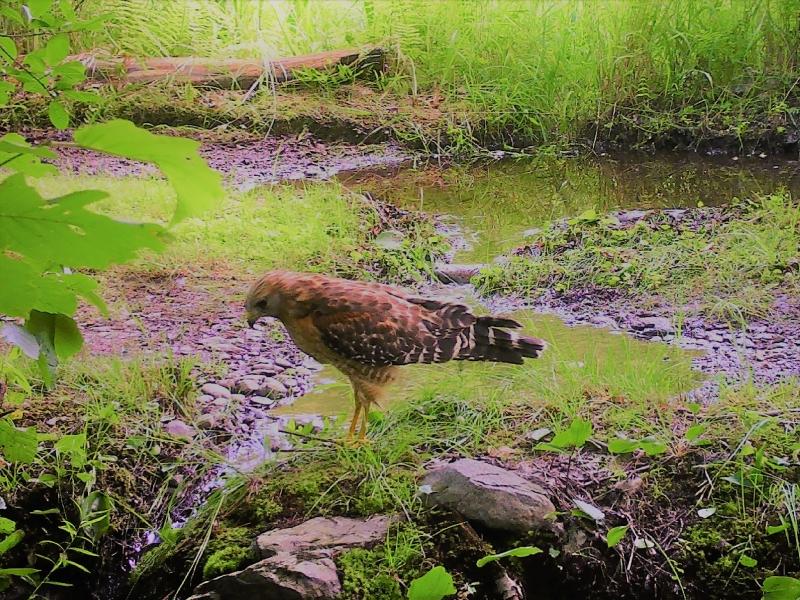 A Red-shouldered Hawk photographed by our neighbor's game camera this summer in Jefferson, Maine when it apparently was searching for frogs or other prey in a little wet area in the forest. Courtesy of Richard Del Gallo
A Red-shouldered Hawk photographed by our neighbor's game camera this summer in Jefferson, Maine when it apparently was searching for frogs or other prey in a little wet area in the forest. Courtesy of Richard Del Gallo
 Among other species detected by our friend's game camera in Jefferson was this handsome bobcat. Courtesy of Richard Del Gallo
Among other species detected by our friend's game camera in Jefferson was this handsome bobcat. Courtesy of Richard Del Gallo
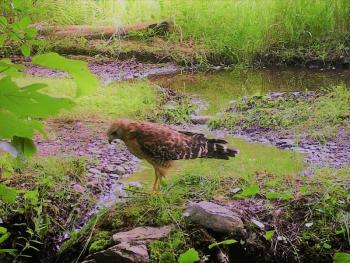 A Red-shouldered Hawk photographed by our neighbor's game camera this summer in Jefferson, Maine when it apparently was searching for frogs or other prey in a little wet area in the forest. Courtesy of Richard Del Gallo
A Red-shouldered Hawk photographed by our neighbor's game camera this summer in Jefferson, Maine when it apparently was searching for frogs or other prey in a little wet area in the forest. Courtesy of Richard Del Gallo
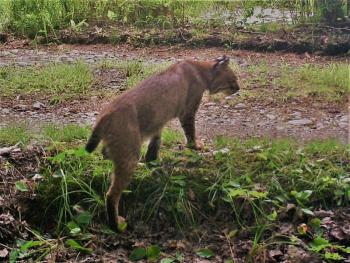 Among other species detected by our friend's game camera in Jefferson was this handsome bobcat. Courtesy of Richard Del Gallo
Among other species detected by our friend's game camera in Jefferson was this handsome bobcat. Courtesy of Richard Del Gallo
Up in the northern reaches of Lincoln County, in the town of Jefferson, our neighbors have a camp on a lake within a large block of largely undisturbed and undeveloped forest, wetlands, streams, and small lakes and ponds. They enjoy wonderful sightings of successfully nesting bald eagles, ospreys, loons, and various duck species.
To try to learn more about the more secretive wildlife that live in the area, ours have installed a trail camera along a game trail near a wet seepage. The camera is triggered automatically when something sets off the infrared motion detector by passing in front of it. The photo or video (depending on how the user has set it up) is saved on an SD card with the date and time on it so that the user can download and it view it at their leisure.
At a recent neighborhood outdoor get-together, the neighbor with the game cam sauntered up to us with a question. What kind of hawk would he have photographed on his game camera, walking around on the ground?
A likely first guess is broad-winged hawk. That’s one of the most widespread summer forest hawks in these parts, and we’ve seen them walking around in wet areas where they hunt for frogs and snakes. As more or less an aside, we mentioned a more uncommon Maine forest-dwelling hawk that also likes to do the same thing: the red-shouldered hawk.
We asked our neighbor to email over the hawk photo as well as some of the other interesting wildlife he has photographed with the camera.
That evening, when we received the photos, we were pleasantly surprised to see that the mystery hawk was indeed a red-shouldered hawk! The bird’s banded tail with wide, black bands and narrow white ones, its reddish shoulder, and other features, made it conclusive.
Red-shouldered hawks reach their northern breeding limits in Maine, although they do occur along the St. Lawrence northeast to just beyond Quebec City and occasionally up into south-coastal New Brunswick. They breed throughout the forested eastern part of the U.S. south to the Gulf Coast states. There’s a separate population that occurs from southwestern Oregon through California and into Baja Mexico.
Red-shouldered hawk populations declined in the latter half of the 1900s but appear to have stabilized and perhaps increased in some regions in recent decades. They prefer and do best in large tracts of older-aged, wet, broad-leaved forests, often near lakes, ponds, streams, and rivers. The red-shouldered hawk detected by our neighbor’s game camera was in perfect habitat; we have no doubt it was nesting nearby.
Large blocks of healthy older-aged forest like the one where this red-shouldered hawk was found are, not surprisingly, great places for lots of other wildlife. On his game camera, our neighbor has found all sorts of cool animals including porcupine, moose, black bear, and a beautiful bobcat. These images help make the case that protecting large blocks of forest is essential if we want wildlife to be part of Maine’s natural heritage for our kids and grandkids. That’s why it’s fantastic that lawmakers this legislative session provided $40 million for the Land for Maine’s Future (LMF) program in the state budget. These funds will provide long-overdue support for land conservation in support of working waterfronts, farmland preservation, recreation—and lands that provide essential habitat for wildlife that, like us, call Maine home.
Jeffrey V. Wells, Ph.D., is a Fellow of the Cornell Lab of Ornithology and Vice President of Boreal Conservation for National Audubon. Dr. Wells is one of the nation's leading bird experts and conservation biologists and author of the “Birder’s Conservation Handbook.” His grandfather, the late John Chase, was a columnist for the Boothbay Register for many years. Allison Childs Wells, formerly of the Cornell Lab of Ornithology, is a senior director at the Natural Resources Council of Maine, a nonprofit membership organization working statewide to protect the nature of Maine. Both are widely published natural history writers and are the authors of the popular books, “Maine’s Favorite Birds” (Tilbury House) and “Birds of Aruba, Bonaire, and Curaçao: A Site and Field Guide,” (Cornell University Press).
Event Date
Address
United States

